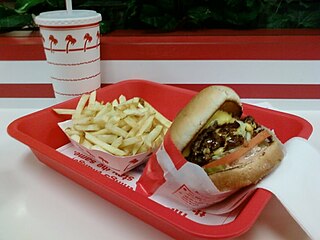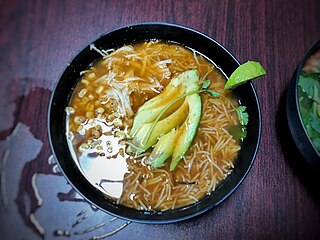
Swedish cuisine is the traditional food of Sweden. Due to Sweden's large north-to-south expanse, there are regional differences between the cuisine of North and South Sweden.

A sandwich is a food typically consisting of vegetables, sliced cheese or meat, placed on or between slices of bread, or more generally any dish wherein bread serves as a container or wrapper for another food type. The sandwich began as a portable, convenient finger food in the Western world, though over time it has become prevalent worldwide.

Hungarian or Magyar cuisine is the cuisine characteristic of the nation of Hungary, and its primary ethnic group, the Magyars. Hungarian cuisine has been described as being the spiciest cuisine in Europe. This can largely be attributed to the use of their piquant native spice, Hungarian paprika, in many of their dishes. A mild version of the spice, Hungarian sweet paprika, is commonly used as an alternative. Traditional Hungarian dishes are primarily based on meats, seasonal vegetables, fruits, bread, and dairy products.

Finnish cuisine is notable for generally combining traditional country fare and haute cuisine with contemporary continental-style cooking. Fish and meat play a prominent role in traditional Finnish dishes in some parts of the country, while the dishes elsewhere have traditionally included various vegetables and mushrooms. Evacuees from Karelia contributed to foods in other parts of Finland in the aftermath of the Continuation War.

A grilled cheese is a hot cheese sandwich typically prepared by heating slices of cheese between slices of bread with a cooking fat such as butter or mayonnaise on a frying pan, griddle, or sandwich toaster, until the bread browns and the cheese melts.

Chipped beef is a form of pressed, salted and dried beef that has been sliced into thin pieces. Some makers smoke the dried beef for more flavor. The modern product consists of small, thin, flexible leaves of partially dried beef, generally sold compressed together in jars or flat in plastic packets. The processed meat producer Hormel once described it as "an air-dried product that is similar to bresaola, but not as tasty."

Panera Bread is an American chain store of bakery-café fast casual restaurants with over 2,000 locations, all of which are in the United States and Canada. Its headquarters are in Sunset Hills, Missouri.

Comfort food is food that provides a nostalgic or sentimental value to someone, and may be characterized by its high caloric nature, high carbohydrate level, or simple preparation. The nostalgia may be specific to an individual, or it may apply to a specific culture.

Jewish cuisine refers to the worldwide cooking traditions of the Jewish people. During its evolution over the course of many centuries, it has been shaped by Jewish dietary laws (kashrut), Jewish festivals and holidays, and traditions centred around Shabbat. Jewish cuisine is influenced by the economics, agriculture, and culinary traditions of the many countries where Jewish communities have settled and varies widely throughout the entire world.
Serbian cuisine is a Balkan cuisine that consists of the culinary methods and traditions of Serbia. Its roots lie in Serbian history, including centuries of cultural contact and influence with the Greeks and the Byzantine Empire, the Ottomans, and Serbia's Balkan neighbours, especially during the existence of Yugoslavia. Historically, Serbian food develops from pastoral customs that involved the keeping of sheep in mountain highlands, in a climate and regional context that favoured animal husbandry over vegetable farming; Serbian food is therefore traditionally richer in animal products and basic grains—corn, wheat and oats—than fresh vegetable dishes. Following the abandonment of widely practiced pastoral lifestyles, Serbian food emerged through the Middle Ages heavily dependent not on lamb or mutton, but on the keeping of pigs for the annual cull and the production of various cured meats, such as sausages, bacon and ham products.
Lunch is a meal eaten around the middle of the day. It is commonly the second meal of the day, after breakfast, and varies in size by culture and region.

Liechtensteiner cuisine is the cuisine of Liechtenstein. The cuisine is diverse and has been influenced by the cuisine of nearby countries, particularly Switzerland and Austria, and is also influenced by Central European cuisine. Cheeses and soups are integral parts of Liechtensteiner cuisine. Milk products are also commonplace in the country's cuisine, due to an expansive dairy industry. Common vegetables include greens, potatoes and cabbage. Widely consumed meats include beef, chicken and pork. The consumption of three meals a day is commonplace, and meals are often formal.

Lettuce soup is a soup prepared with lettuce as a primary ingredient. It may be prepared with myriad lettuces and other ingredients, and some lettuce soups may use several cultivars of lettuce in their preparation. It is a part of French cuisine and Chinese cuisine. Cream of lettuce soup is a type of lettuce soup prepared using milk or cream. The soup may be served with toast or rolls as a side dish or with the soup atop them. It may be served as an appetizer, a side dish or as a main dish, and may be served hot or cold.

A meal is an eating occasion that takes place at a certain time and includes consumption of food. The names used for specific meals in English vary, depending on the speaker's culture, the time of day, or the size of the meal.

A combination meal, often referred as a combo-meal, is a type of meal that typically includes food items and a beverage. They are a common menu item at fast food restaurants, and other restaurants also purvey them. Combination meals may be priced lower compared to ordering items separately, but this is not always the case. A combination meal is also a meal in which the consumer orders items à la carte to create their own meal combination.

Sopa de fideo, also referred to as sopita de fideo, is a stock-based noodle soup that is a part of the cuisines of Spain, Mexico, and Cavite, a province in the Philippines. It has been suggested that the dish may have originated in Spain.
















